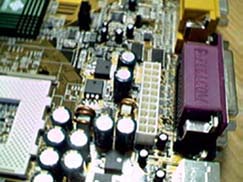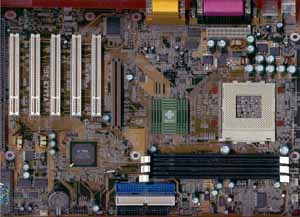
Original Link: https://www.anandtech.com/show/625
Soyo SY-K7VTA Socket-A KT133 ATX
by Henry Kuo on September 22, 2000 12:33 AM EST- Posted in
- Motherboards
Soyo has been around for 15 years, but they have just recently become known among hardware enthusiasts. The release of their SY-6BA+III and SY-6BA+IV motherboards running the Intel 440BX chipset last year really helped to put Soyo on the map. Now, the stability and performance of these boards is well known.
The Athlon series of processors from AMD helped to capture a considerable amount of CPU market, and the release of Durons and Thunderbirds in June took AMD to another level. With the migration from Slot-A to Socket-A, it was a good time for a “new” chipset. However, AMD did not do it alone; it got help from VIA. VIA released the KT133 chipset with the new series of AMD processors.
Since then, a lot of motherboard manufacturers have released their Socket-A / KT133 solution. Among them is Soyo, who released the SY-K7VTA. Let’s see if the performance of the SY-K7VTA can surprise us in any way.
|
Soyo SY-K7VTA |
|
|
CPU
Interface
|
Socket-A
|
|
Chipset
|
VIA
KT133
|
|
Form
Factor
|
ATX
|
|
Bus
Speeds
|
100
/ 102 / 103 / 107 / 110 / 113 / 117 / 120MHz
|
|
Voltages
Supported
|
Auto Detect
|
|
Memory
Slots
|
3
168-pin DIMM Slots
|
|
Expansion
Slots
|
1
AGP Slot |
|
On-board
Audio
|
Sigmatel
STAC9744T AC 97 CODEC
|
|
BIOS
|
Award
Modular BIOS 6.00PG
|
The Good
The SY-K7VTA utilizes a moderately sized PCB, though not as large as the ABIT KT7 or the ASUS A7V. The layout of the PCB is quite “standard,” with most parts sitting where they usually are on most boards. One thing to notice is that the ATX power supply connector is placed close to the back of the motherboard, next to the ATX I/O shield and a couple of large capacitors. This means you’ll have to run your ATX power cable over your memory and CPU, potentially cluttering up the case with cables. Also, by having the power supply connector there, the power cables may affect the cooling of the CPU by blocking airflow.
The VIA 8373 North Bridge sits between the 462-pin Socket-A connector and the AGP slot, which is the core of the KT133 chipset. It provides all the major features of the KT133, including the 133 MHz memory bus and AGP 4X support. Just like almost every motherboard in the market today, the AGP slot is a “universal AGP slot,” which means it is not keyed specifically for AGP 2X or AGP 4X cards, so the user can install almost any current AGP card in the slot.
The SY-K7VTA has a memory limit of 1.5GB, which is provided directly by the KT133 chipset in combination with three physical 168-pin SDRAM DIMM slots. The 8373 memory controller is nice enough to let you run your memory at either 133MHz or 100MHz. Therefore, users with PC133 SDRAM can take advantage of the increased bandwidth over PC100 SDRAM, going from 800MB/s to 1.06GB/s.
 In
order to maintain good stability, Soyo puts thirteen 1500uF capacitors around
the 462-pin socket-A, which helps to ensure that the signals driving into the
CPU is clean enough and there is sufficient power.
In
order to maintain good stability, Soyo puts thirteen 1500uF capacitors around
the 462-pin socket-A, which helps to ensure that the signals driving into the
CPU is clean enough and there is sufficient power.
The 5/1/0/1 (PCI/AGP/CNR/ISA) expansion slot configuration on SY-K7VTA should be enough to satisfy most users. The lack of any CNR expansion slot should be good news for all hardware enthusiasts. The ISA slot provides a chance for people that just cannot give up their ISA hardware, such as a modem or old SCSI card for tape drives. Since the VIA 686A “Super” South Bridge features a integrated PCI-ISA bridge, the only additional cost of including an ISA slot on the SY-K7VTA is the cost of mounting the physical slot on the board.
Moreover, the VIA 686A South Bridge also features support for up to 4 USB devices. Beside the two traditional USB ports mounted at the back of the motherboard together with the serial / parallel ports, there is also a connector ready for USB 3 and 4 in the front of the board. However, in our evaluation sample Soyo did not include the necessary cables for those extra USB ports.
The SY-K7VTA is using the Award Modular BIOS 6.00PG, which supports the Jumperless CPU setup. The FSB settings can be found under Frequency / Voltage Control in the BIOS. FSB settings include 100 / 102 / 103 / 107 / 110 / 113 / 117 / 120. From our experience, the EV6 bus of AMD’s chips cannot maintain much stability at FSB higher than 110MHz (there are always some exceptions ;), so settings over 110MHz are not that useful. We would have preferred more FSB settings between 100MHz and 110MHz so that users can squeeze the last bit of power from the CPU.
In the BIOS, users can also check the PC Health Status. From there, users can get information on the CPU temperature, system temperature, and also the speed of two fans. It also reports the voltage for the CPU and AGP.
The Sigmatel STAC9708T AC 97 CODEC provides some basic sound card features for the SY-K7VTA. However, for users who care about their 3D PC sound would definitely want a PCI sound card to get some higher quality sound effects.
Another feature of the SY-K7VTA is the use a diagnostic set of LED’s, similar to MSI’s D-LED, that are placed at the left hand side and closed to the back of the board. The 4 LED’s blink green and red during startup as different components on the motherboard is initialized. When everything is done successfully, all LEDs will be green. If there is a problem, simply compare the pattern of the LED’s to the various combinations shown in the manual for troubleshooting.
There are also two other LED’s; one is to indicate whether there is power supplied to the motherboard, and the other one is to indicate if there is power supplied to the AGP slot, so users will know if it is safe to touch the motherboard or take out the video card.
Bundled with the motherboard there is the Soyo CD, which has all the drivers and utilities you need for your motherboard. Although we could not find a manual in our evaluation sample package, but from experience Soyo usually includes a user manual with all the details for first time users, and there are also details on the BIOS settings. Also included in the box is the Soyo “3 in 1” Bonus Pack, which includes the Norton Ghost, Norton Antivirus, and Norton Virtual Drive. Norton Ghost is very useful in cloning hard disk; Norton Antivirus is definitely important for every computer system; and Norton Virtual Drive can copy your CD to hard disk for ultra-fast access.
The Bad
We have already noticed some manufacturers including ATA100 controller on their motherboards. Although at the current time, there is no way we can have a sustained transfer rate of higher than 40MB/s, if Soyo had included an ATA100 controller, they could have probably “prolonged” the life of the motherboard. Indeed when VIA releases the VIA 686B South Bridge, which includes ATA 100 controller, at the end of the year, Soyo can probably include ATA100 feature easily. But again, there is no real benefit for now.
Overclocking is very important to AnandTech readers, but the SY-K7VTA does not provide enough FSB settings between the 100MHz and 110MHz FSB range, which is what we expected. Beside the FSB settings, it would also be nice if Soyo had included the ability to change the multiplier for CPU, something that ABIT and ASUS has done and something that is much more useful when overclocking your CPU.
In our evaluation sample, Soyo did not include the necessary cables to take advantage of the 2 extra USB ports onboard. We are not sure if they do include that in the retail version, but it would definitely be something nice to have.
Last of all, the diagnostic LED is a very good feature. However, it would be even better if they can be viewed from the outside of the case, perhaps through the I/O shield.
USB Compatibility
· Number of Front Universal Serial Bus Root Ports: 2
· Number of Rear Universal Serial Bus Root Ports: 2
· USB IRQ Enable/Disable in BIOS: Yes
· USB Keyboard Support in BIOS: Yes
Recommended SDRAM
Recommended SDRAM: 1 x 128MB Corsair PC133 SDRAM; 1 x 128MB Mushkin PC133 SDRAM
SDRAM Tested: 1 x 128MB Mushkin PC133 SDRAM
Manufacturer: Corsair
Purchase Website: http://www.corsairmicro.com
Manufacturer: Mushkin
Purchase Website: http://www.mushkin.com
The Test
In recent times, choosing a motherboard cannot be completely determined by a Winstone score. Now, many boards come within one Winstone point of each other and therefore the need to benchmark boards against each other falls. Therefore you should not base your decision entirely on the benchmarks you see here, but also on the technical features and advantages of this particular board, seeing as that will probably make the greatest difference in your overall experience.
Click Here to learn about AnandTech's Motherboard Testing Methodology.
|
Test Configuration |
|
| Processor(s): |
AMD
Athlon (Thunderbird) 800MHz
|
| RAM: |
1 x 128MB Mushkin PC133 SDRAM
|
| Hard Drive(s): |
Western Digital 153BA Ultra
ATA 66 7200 RPM
|
| Bus Master Drivers: |
VIA Bus Master Drivers 2.1.47
|
| Video Card(s): |
NVIDIA
GeForce 2 GTS 32MB DDR
|
| Video Drivers: |
NVIDIA
Detonator 5.22
|
| Operation System(s): |
Windows
98 SE
|
| Motherboard Revision: |
Soyo
SY-K7VTA Revision A
|
|
Windows 98 Performance |
|||
|
Sysmark
2000
|
Content
Creation
Winstone 2000 |
Quake
III Arena - 640 x 480 x 16
|
|
| Soyo SY-K7VTA - Athlon 800 |
160
|
27.5
|
127.0
|
Final Words
Compared to other Socket-A motherboards we have reviewed, the performance of the Soyo SY-K7VTA is not overly surprising. It has everything that a basic Socket-A motherboard should have, so for users who want a Thunderbird or Duron system with “normal” features, SY-K7VTA is definitely a good choice. However, for users who want more tweaking power, for example more FSB settings, multiplier tweaking, RAID, ATA100 support, etc. may want to look somewhere else for a motherboard that can satisfy them.
How it Rates
|
AnandTech Motherboard Rating |
|
|
Rating
(x/10)
|
|
|
Performance
|
5.0
|
|
Price
|
5.5
|
|
Stability
|
7.5
|
|
Quality
|
7.0
|
|
Features
|
5.5
|
|
Layout
|
4.5
|
|
Availability
|
8.0
|
|
Documentation & Software Bundle
|
7.5
|
| Overall Rating - not an average Click here to find out why |
6.0
|








